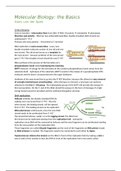Resume
Summary: Molecular Biology of the Cell
- Cours
- Établissement
- Book
This summary includes all the lectures of the course Molecular Biology of the Cell of the master Biomedical Sciences - lectures were given by Maike Stam, Hans van der Spek and Stanley Brul.
[Montrer plus]




